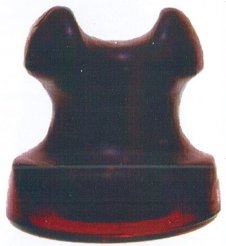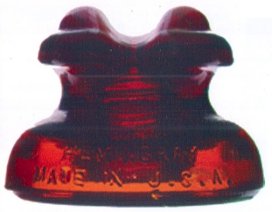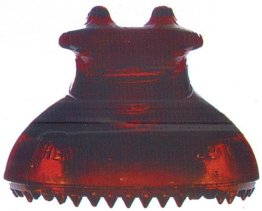For Valentine's, Crown Jewels presents "red" insulators found in
the hobby.
The idea of a red glass insulator has captured the thoughts of collectors
since the hobby began. When I was collecting in the 1960's, collectors wondered
if a red insulator would ever be found. Even today, if you talk to
non-collectors at flea markets and antique shops, they'll relate stories of red
glass insulators being found... usually... at some remote, far away place.
Were
genuine insulators ever made in red glass? In a 1909 catalog, Hemingray
advertised "special colored glass insulators". The ad reads,
"Where several lines of different companies are on the same cross arm, the
lineman can distinguish his line by the color of the insulator. Different
currents can also be designated by different colored insulators. We are prepared
to furnish all styles of insulators in RED, blue, and amber glass..."
(emphasis added). The advertisement went on to say that there was an extra
charge of $8.00 per thousand for insulators made in colored glass.¹
CD 162 style
Hemingray's were offered for $84.40 per thousand in ordinary "green
glass", what we would call aqua colored glass today. That means for $92.40
you could have ordered one-thousand cobalt blue insulators... or one-thousand
amber insulators... or even one-thousand red glass insulators.
Is it possible
that oxblood colored insulators such as the one shown on the opposite page were
sold as red glass? Were they red when they were made? Did they fade, or turn, to
red amber or orange amber over time?
Today, the truest "red"
insulators are both recent commemoratives. The VTS CD 102 pony shown on the
inside of the front cover comes in truly red glass. It was made in the early
1970's. Some McLaughlin commemoratives, made in 1972, are a dramatic red color
(see page 18). But insulators made for actual service on lines seem to have only
be found in "reddish" colors.
Shown below:
CD 114 HEMINGRAY / No 11 (front) / PATENT MAY 2 1893 (reverse) in red amber.
Only three examples are known. McDougald's price guide values this item at
$5,000 to $7,000.
CD 162 H.G. CO. / PATENT MAY 2 1893 (front) / PETTICOAT (reverse) in oxblood.
This dark red coloration is distinctly different than red amber. Oxbloods are
tough to find, and are valued in the price guide at $1,500 to $1,750.
CD 214 TELEGRAPHOS (front) / NACIONALES (reverse). These Mexican insulators
are found in red amber, and are much more affordable than some of the other
reddish colored insulators shown in this article. The price guide lists them at
$75 to $100.
VALENTINE'S SPECIAL:
RED INSULATORS OF THE HOBBY

CD 162 Oxblood Red

CD 114 Red Amber

CD 214 Dark Red Amber
Seeing Red on Valentines

In 1972, William McLaughlin made commemorative
insulators that were truly red
glass (CD 162 style above).

CD 272 Whitall Tatum insulators are common in amber.
Some are found
in a strong red amber. However,
the density of the glass is such the red tones
are hard to bring out.

CD 230 Hemingray D-512 in Red Amber

CD 241 Hemingray 23 in Red Amber
Obviously, one of the most dramatic red insulators in the hobby is the
commemorative made by William McLaughlin in 1972. The style imitates the CD 162
shape and is embossed MCLAUGHLIN #19 (front) 1897-1972 (reverse). William
McLaughlin began work at the Robert Good's insulator factory in the Denver area
in 1897, and the insulators commemorated the 75th anniversary of that event.
McLaughlin reportedly made 672 commemoratives in 1972, of which only 72 were red
milk like the one shown on the opposite page.² The Price Guide values the commemorative in red milk glass at $800 to $1,000.
CD 272 WHITALL TATUM. Compared to the red commemorative, the Whitall Tatum
hardly looks red at all. But I know one insulator dealer who kept red marbles at
his table when he had red CD 272's for sale. If you just looked at the marble,
it was red glass without a doubt. Then he would have you hold the marble up next
to the Whitall Tatum, and they were the same color of glass! It was the density
of the glass that made the insulator look more amber than red. The Price Guide
values them at $10 to $15.
CD 230 HEMINGRAY D-512. All three of the actual insulators shown
above were made in the second quarter of the 20th Century. It was a time
when makers of glass insulators were having to compete with porcelain insulator
manufacturers for market share. Many low voltage glass insulators made during
this period were formed in dark colored glass to compete with similarly colored
porcelain items. The Price Guide lists D-512's in red amber at $50 - $75.
CD 241 HEMINGRAY - 23. Another reddish insulator is the fragile CD 241 with
its sharp drip points. In red amber, the Price Guide values these at $75 - $100.
Other red glass insulators can be found in the hobby, including some of
National Show commemoratives. If you have a red insulator to show off, Crown
Jewels would like to receive a picture of it. ... Howard Banks
References:
1. Hemingray Glass Company, by H.G. "Bea" Hyve, 1998, page 337.
2. Dreams of Glass: The Story of William McLaughlin and His Glass Company, by
Fred Padgett, 1996, pages 220-229.
Insulators Price Guide, by John & Carol McDougald, 2003.
Picture Credits:
Bill Ostrander: CD 214, CD 272, CD 230 & CD 241
Ray Klingensmith:
McLaughlin Commemorative
ICON: CD 114 & CD 162.


































































